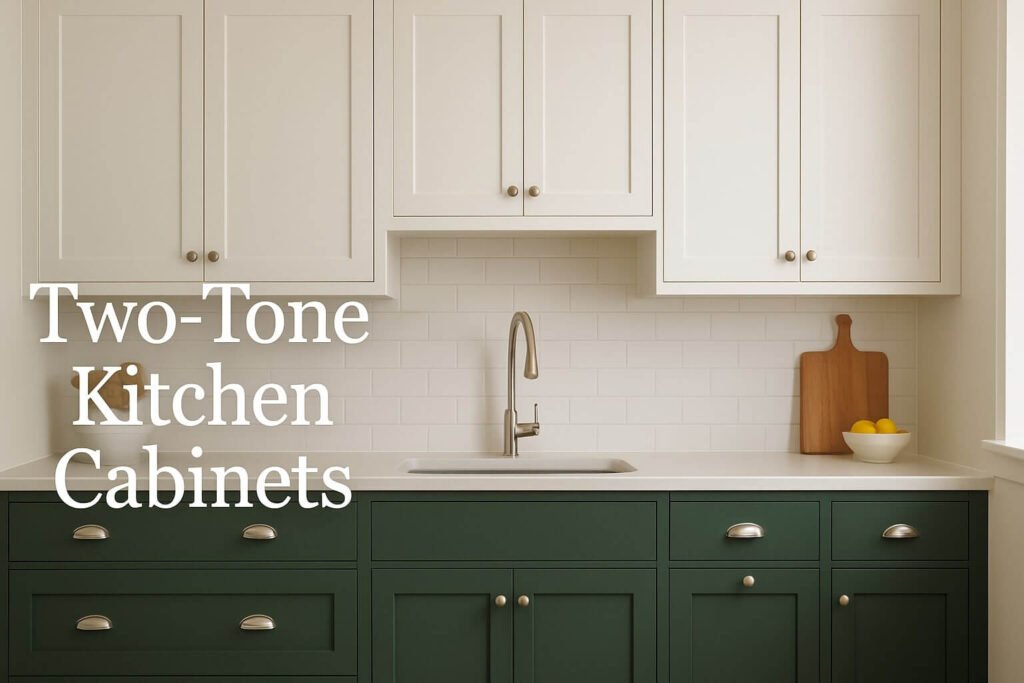A steaming mug in hand, I watched a neighbour’s 1930s semi transform last spring. First came the dusty rip-outs, then the trades quietly fitted tall textile-white cupboards above deep forest-green drawers. When the protective film finally peeled away, the whole room felt taller, wider, brighter—yet oddly grounded. Those two-tone kitchen cabinets became the talking point of every street barbecue, sparking my own dive into the design shift sweeping Britain’s households this year. If you are weighing colour cards right now, read on. In true Homecraft Chronicle style, I will steer you through the why, the how, and the keep-it-looking-fresh rules of two-tone kitchen cabinets, sprinkling in real costs, on-site shortcuts, and the 2025 palettes catching every estate agent’s eye.
Why Two-Tone Cabinets Win in 2025
Two-tone kitchen cabinets tick three big boxes for today’s renovator: personality, practicality, and property value. Colour blocking top and bottom sections—think off-white uppers over navy bases, or pale ash towers beside matte-black islands—creates instant focal points without crowding the senses. Property analysts report that family buyers now shortlist listings with two-tone kitchen cabinets because the look signals a recently updated space, saving them renovation headaches later. For your daily routine, the split finish also works hard. Light tints at eye level reflect daylight, lowering the need for extra task lighting, while darker shades on lower cupboards disguise shoe scuffs and toddler bumps. Sustainability adds another win. Many homeowners keep their existing carcasses, repainting doors in two complementary hues, which cuts landfill waste and shaves up to twenty five percent off a full rip-and-replace budget.
Money matters too, so let us demystify expenses. Factory-sprayed new doors in two colours cost about five to seven percent more than a single-tone order because the spray booth resets between shades. On a mid-size kitchen that bump is usually under five hundred pounds—cheaper than marble splashbacks or a brand-name tap upgrade. Tight budget? Sand and prime your current doors, then send them to a local spray shop. You will pay roughly forty pounds per panel, gaining that crisp showroom sheen for a quarter of bespoke door prices. Whatever path you choose, two-tone kitchen cabinets promise a style payoff that belies the spend.
Step-by-Step: Designing Your Two-Tone Kitchen Cabinets
1. Audit, then measure twice
Open a notebook and map out every carcass. Confirm hinges sit tight, gables are square, and plumbing can stay put. Repainting only works when the backbone is sound.
2. Pick a hero shade, not two at once
Start with either your lower run or central island. Many UK designers currently champion mid-green, ink-blue, or charcoal as anchoring colours. Once that hero stands firm, choose a lighter neutral—ivory, porcelain, or light cashmere—for uppers and bridging cabinets. Limiting yourself to one bold and one quiet hue keeps two-tone kitchen cabinets elegant rather than patchwork.
3. Test in real light
Cut price tags off sample doors or paint MDF boards. Prop them against existing tiles morning and evening. Britain’s overcast skies shift undertones dramatically. If the green leans murky at dusk, step two shades lighter.
4. Mind the materials
Painted solid ash fronts pair beautifully with oak-edged larder towers. If your budget runs leaner, opt for sustainably sourced MDF wrapped in a hardy lacquer. Combine textures sparingly so the eyes rest on the colour contrast, not competing grains.
5. Hardware harmony
Two-tone kitchen cabinets sing when handles tie the palette together. Brushed brass bridges warm neutrals with deep blues, while matte black sets a modern line against oak frames. Measure hole centres before ordering replacements, avoiding the extra chore of filler and drill.
6. Schedule smart
Line up painter, electrician, and worktop team in succession. Doors must be fully cured before handles go on, so pad your calendar with forty-eight hours of drying time. Rushing here risks fingerprints immortalised beneath the lacquer.
7. Photograph the journey
Snap before, during, and after shots. Social posts featuring the messy middle often capture twice the engagement of polished reveals, a handy bonus if you plan to flip or Airbnb your home later on.
Pro Care Tips and Future Proofing
Living with two-tone kitchen cabinets is blissfully low maintenance once a few habits set in. Wipe door fronts weekly with a microfibre cloth and a diluted plant-based cleaner. Skip abrasive pads that dull satin sheens. Re-oil timber accents every spring to maintain depth. Store a tester pot of each colour; micro-roll touch-ups along kick plates take minutes and keep the contrast crisp.
Thinking long term, palette flexibility is key. Trend forecasters predict warm walnut and butter-cream combinations rising by late 2025. Because two-tone kitchen cabinets isolate colour to door skins and end panels, you can refresh the vibe with a single repaint rather than tearing out cabinetry. Swap handles to match the new tone, and the heart of your home feels newly minted again. This modular approach aligns perfectly with eco-conscious living, reducing waste and stretching renovation budgets further.
Final nudge: if a full makeover feels daunting, experiment on one freestanding piece first. Paint that forgotten larder cupboard or a wall-mounted dresser in split shades. As confidence grows, roll the look across the entire run. Two-tone kitchen cabinets reward bold moves, yet they remain forgiving, letting you recalibrate colour choices over the years without heavy structural work.
Enjoy designing, installing, and living in your own layered masterpiece. With a measured plan, a splash of daring colour, and the practical pointers above, your two-tone kitchen cabinets will turn everyday cooking into a visually uplifting ritual and add solid resale leverage when the next chapter calls.


